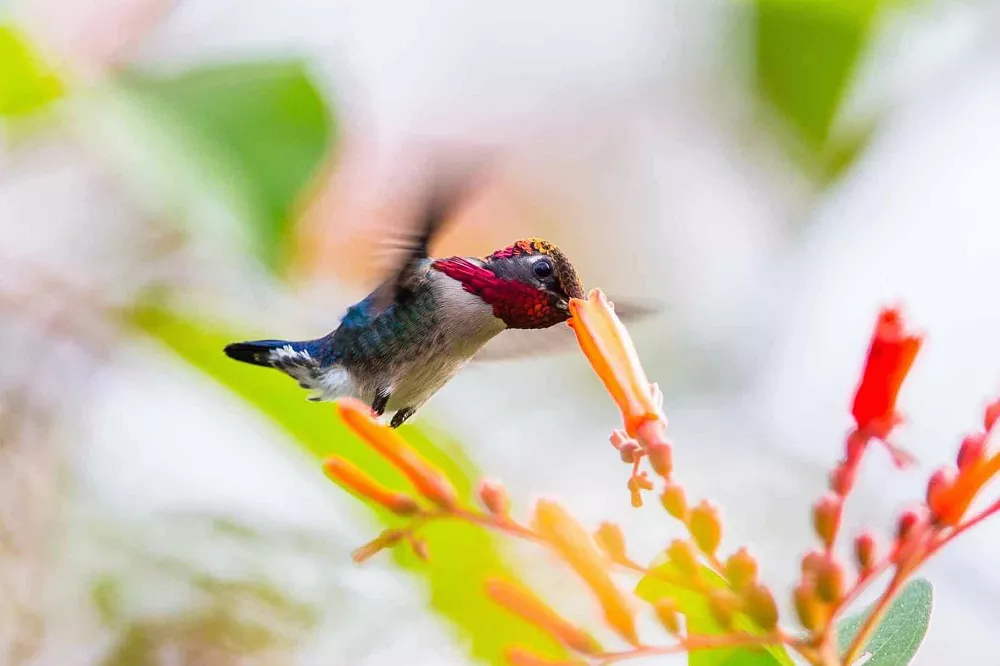The Bee Hummingbird (Mellisuga helenae) is the smallest bird in the world, measuring just 2.25 inches long and weighing in at only 2.6 grams. Despite its diminutive size, this tiny bird is a skilled pollinator and requires a diverse diet to maintain its high metabolism. In this article, we’ll take a closer look at what the Bee Hummingbird eats and how it obtains its food.
Diet of the Bee Hummingbird
The Bee Hummingbird is an omnivorous bird and feeds on a variety of foods. The majority of its diet consists of nectar from flowers, which provides the energy the bird needs to maintain its high metabolism. In addition to nectar, the Bee Hummingbird also feeds on insects and spiders, which provide a source of protein and other nutrients.
Nectar is the primary source of food for the Bee Hummingbird, and the bird must consume up to eight times its body weight in nectar each day to survive. The bird obtains nectar by inserting its long, thin beak into the flower’s corolla and using its long, extendable tongue to lap up the nectar. The Bee Hummingbird is particularly fond of red and orange flowers, which tend to have a higher concentration of nectar than other colors.
In addition to nectar, the Bee Hummingbird also feeds on small insects and spiders. The bird catches its prey by hovering in front of flowers or foliage and plucking the insects or spiders out of the air. The Bee Hummingbird has a very high metabolism, and the protein and other nutrients provided by insects and spiders are essential to its diet.
Feeding Habits of the Bee Hummingbird
The Bee Hummingbird is an active feeder, consuming almost half of its body weight in food every day. To meet its high energy demands, this bird must feed frequently throughout the day. It feeds mostly during the early morning and late evening hours when flowers are most abundant.
To conserve energy, the Bee Hummingbird shuts down its metabolic rate at night and enters a state of torpor, where its heart rate slows down significantly. This ability to enter torpor allows the bird to survive without food for several hours at a time.
How the Bee Hummingbird Obtains its Food
The Bee Hummingbird has several adaptations that allow it to obtain its food efficiently. Its long, thin beak and extendable tongue are perfectly designed for accessing nectar deep inside flowers. The bird’s wings beat incredibly quickly, allowing it to hover in front of flowers or foliage while it feeds.
The Bee Hummingbird is also an agile flier, capable of flying forwards, backwards, and even upside down. This ability allows the bird to access nectar from a wide variety of flowers and to catch insects and spiders in mid-air.
In addition to its physical adaptations, the Bee Hummingbird has a highly developed sense of sight and can easily detect the bright colors of flowers and the movement of insects and spiders. The bird’s sense of smell is also well-developed and helps it locate flowers that are high in nectar.
Conservation Efforts for the Bee Hummingbird
Despite its significance to the ecosystem, the Bee Hummingbird is currently listed as endangered by the International Union for Conservation of Nature (IUCN). The bird’s habitat in Cuba is rapidly shrinking due to deforestation and human development. Additionally, climate change is affecting the availability of the bird’s food sources.
Various conservation efforts have been put in place to protect the Bee Hummingbird, including habitat restoration projects and public awareness campaigns. These efforts aim to increase the bird’s population size and ensure its survival for future generations.
Conclusion
In summary, the Bee Hummingbird is an omnivorous bird that feeds primarily on nectar from flowers, as well as small insects and spiders. The bird’s small size and high metabolism require it to consume a diverse diet to survive. The Bee Hummingbird has several adaptations that allow it to obtain its food efficiently, including its long, thin beak and extendable tongue, its agile flight capabilities, and its highly developed sense of sight and smell.
Related Topics:
- How long do Hummingbirds live?
- What are Hummingbirds predators?
- 7 Fun Facts About Hummingbirds: You Must Be Interested


 Facebook
Facebook  Instagram
Instagram  Youtube
Youtube 